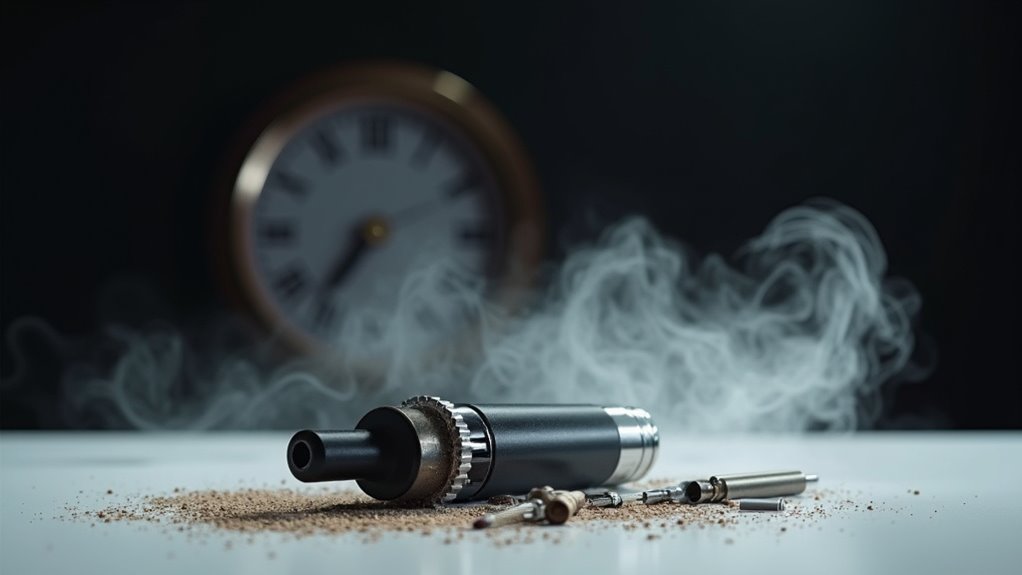Your vape addiction recovery unfolds across distinct phases. You’ll experience physical withdrawal symptoms like headaches and cravings for 1-3 days, followed by psychological challenges lasting 1-2 weeks. While acute symptoms subside relatively quickly, complete biochemical restoration of your body takes 9-12 months. During this time, you’ll notice progressive improvements in breathing, energy, and mental clarity. Understanding the full timeline can help you prepare for each recovery milestone ahead.
The Science Behind Nicotine Elimination

When you stop vaping, your body begins a complex process of eliminating nicotine and its primary metabolite, cotinine. Your liver’s CYP2A6 enzyme converts nicotine to cotinine, which accounts for 70-80% of nicotine’s metabolites in your system. This enzymatic breakdown variability differs among individuals due to genetic factors and general health status. Withdrawal symptoms typically begin within 24 hours of your last use. Physical activity can enhance the elimination process since increased sweating helps excrete nicotine faster from your system.
The elimination timeline typically spans 1-3 days for nicotine in your bloodstream, while cotinine can persist for up to 10 days. If you’re exposed to menthol, your clearance time may increase dramatically. Menthol exposure impacts the excretion rate of cotinine, potentially extending detection periods in urine tests. Your maturity, liver function, and body composition also play pivotal roles in determining how quickly you’ll eliminate these substances, with older adults often experiencing slower metabolism rates. Most people who regularly vape will show cotinine levels between 1,000-8,000 ng/mL in their urine during testing.
Physical and Mental Changes During Recovery
As your body eliminates nicotine, you’ll experience a complex series of physical and mental changes that follow a predictable pattern. During the initial 48 hours, your neurotransmitter balance undergoes significant adjustments as nicotine leaves your system, impacting both physical comfort and emotional regulation. Most people experience withdrawal symptoms that last about a month. Those who successfully navigate the first week of recovery show higher quit success rates. Nearly all individuals who quit vaping experience less mental stress.
Key changes you’ll experience include:
- Physical withdrawal peaks within 4 hours, with headaches and circulation changes occurring by day 2
- Emotional fluctuations intensify at 24 hours, including anxiety and mood swings
- Sleep disturbances and cognitive challenges emerge early but resolve within 1-2 weeks
- Natural dopamine production gradually increases, leading to improved mood stability
Your brain chemistry will stabilize over several weeks, with cravings diminishing and psychological resilience strengthening as you develop healthier coping mechanisms.
Critical Milestones in the First Month

The initial month of vape addiction recovery presents distinct and predictable milestones that signal your progress in the direction of nicotine independence.
During the initial 72 hours, you’ll face intense cravings and physical symptoms, with peak withdrawal occurring between days 3-7. This period demands sturdy relapse prevention strategies as you navigate heightened irritability and sleep disruptions. You may notice an intense craving for sweets as your body adjusts to functioning without nicotine.
Understanding Long-Term Health Improvements
Breaking free from vape addiction triggers a cascade of considerable health improvements throughout your body’s major systems. As you progress through recovery, you’ll experience remarkable transformations that solidify your decision to quit.
Key long-term improvements include:
- Your respiratory system regenerates completely by month 9, with restored cilia function and boosted oxygen capacity, dramatically reducing your risk of pneumonia. Research shows that avoiding e-cigarette aerosols leads to significantly reduced lung irritation. Most people experience peak withdrawal symptoms within the first 72 hours of quitting.
- Cardiovascular health rebounds within 3-6 months as blood vessels regain flexibility and blood pressure normalizes. Your risk of experiencing a heart attack drops by half after one year of staying vape-free.
- Your immune system strengthens considerably, achieving full cilia motility by month 9 and improved antibody response
- Mental clarity gains and improved sleep quality emerge as your body rebalances hormones, particularly noticeable after the 6-month mark when cortisol levels stabilize and energy regulation optimizes
Key Success Factors for Sustainable Recovery

While restoring your body’s health marks substantial progress, achieving lasting freedom from vape addiction depends on implementing proven success strategies. Research shows that multi-pronged intervention strategies combining counseling and medication can triple your success rates compared to single approaches. Digital cessation tools like online quit programs quadruple the chances of successfully breaking free from tobacco use. Your recovery journey benefits most from individualized treatment plans that address your unique challenges. Whether you’re dealing with dual-use habits or specific triggers, customized approaches incorporating behavioral therapy, support groups, and nicotine replacement can considerably improve your outcomes. Having a structured aftercare program and relapse prevention strategy guarantees you’ll maintain your progress through challenging phases. The increasing popularity among youth, with 27.5% of high schoolers using e-cigarettes, emphasizes the importance of early intervention in addiction recovery. Since former smokers demonstrate the strongest motivation to quit vaping, their experiences can provide valuable insights for developing effective cessation strategies.
| Success Factor | Impact |
|---|---|
| Combined Treatment | 3x higher quit rates with counseling + medication |
| Professional Support | Healthcare provider training doubles success odds |
| Social Networks | Family/friend involvement strengthens recovery |
Frequently Asked Questions
Can I Occasionally Vape Socially After Quitting Without Becoming Re-Addicted?
No, you can’t safely engage in occasional social vaping after quitting. Even minimal nicotine exposure reactivates addiction pathways in your brain, risking full relapse.
Research shows there’s no “safe” level of occasional use, as nicotine receptors remain sensitive to reactivation. Instead, focus on relapse prevention strategies like avoiding trigger situations and developing alternative social activities.
Your best chance at lasting freedom from nicotine depends on complete abstinence.
How Does Vaping During Pregnancy Affect the Recovery Timeline?
There’s limited direct research on how pregnancy specifically affects vaping recovery timelines. However, you’ll face unique challenges due to hormonal changes and heightened stress during pregnancy.
Fetal development impacts make immediate cessation pivotal, as nicotine can harm your baby’s brain and lung development. Maternal health concerns, including increased blood pressure and reduced oxygen flow, make quitting indispensable.
You should consult your healthcare provider for pregnancy-specific cessation support and monitoring.
Will Switching to Nicotine Patches Change the Overall Recovery Duration?
Switching to nicotine patches won’t necessarily shorten your comprehensive recovery duration, but it can make withdrawal symptom management more manageable. You’ll experience a more controlled nicotine replacement dosage that gradually decreases over time.
While physical withdrawal may extend slightly due to continued nicotine exposure, you’re likely to have better success managing severe cravings. The psychological recovery timeline remains similar, typically lasting months to years regardless of your cessation method.
Does Vaping Cannabis Impact the Nicotine Addiction Recovery Process?
While specific research is limited, your cannabis use may complicate nicotine recovery. If you’re vaping both substances, you’ll likely experience overlapping cannabis withdrawal symptoms alongside nicotine withdrawal.
Using cannabis as a vaping habit replacement isn’t recommended, as it could potentially extend your recovery timeline and create dual dependency issues. You’ll achieve better outcomes by addressing both substances separately with professional guidance, rather than substituting one for the other.
Can Certain Medications Speed up or Slow Down Vape Addiction Recovery?
Medications can greatly impact your nicotine withdrawal recovery process. Both nicotine replacement therapy (NRT) and non-nicotine medications like bupropion and varenicline can help accelerate recovery by reducing withdrawal symptoms and cravings. However, these medications’ therapy effectiveness impacts vary among individuals.
While NRT provides a controlled step-down approach, prescription medications work by targeting brain receptors directly. You’ll achieve the best results when combining medications with behavioral counseling.










